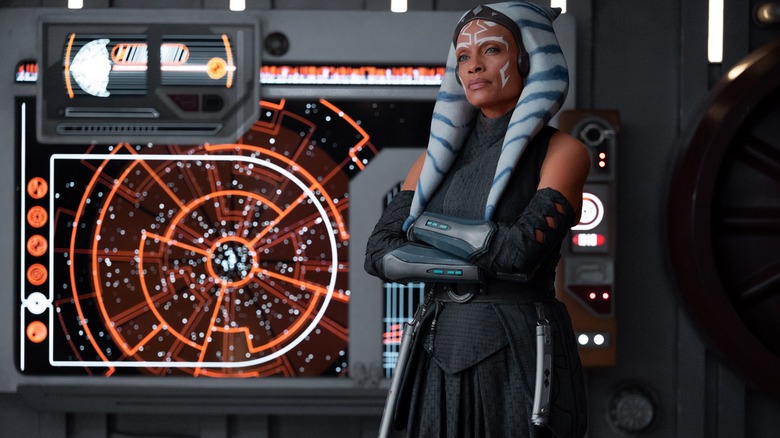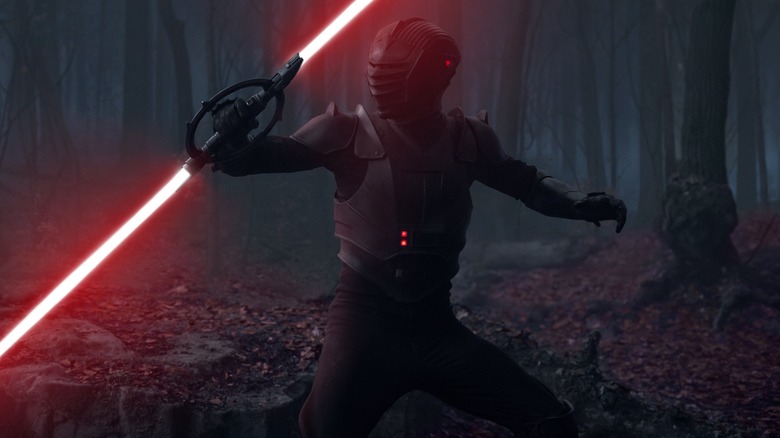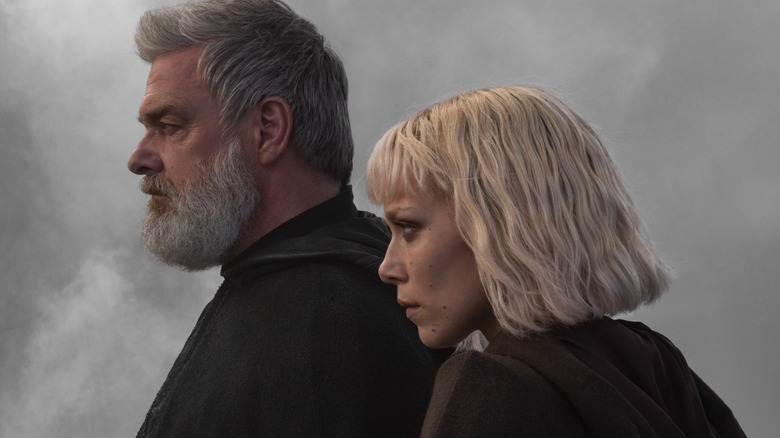Ahsoka Features A Classic Star Wars Element – But A First For Star Wars TV
This post contains spoilers for episode 1 of "Ahsoka."
The word "iconic" should be deserved for things that truly deserve that moniker, and the classic "Star Wars" opening crawl can definitely be classified as iconic. Apart from being the signature opener for the cinematic entries in the franchise, the opening crawl offers swift and digestible exposition before every film starts, allowing the story to plunge right into the midst of things. While the opening crawl has been a staple in most "Star Wars" films (with a few exceptions like "Rogue One," where it was a deliberate choice to differentiate it from the Skywalker Saga), the franchise's Disney+ shows generally strayed away from this film-specific visual trope. Interestingly, "Ahsoka" breaks this trend by incorporating an opening crawl right before the season premiere, which is a first for "Star Wars" TV.
This surely is an intriguing choice, as Lucasfilm president Kathleen Kennedy previously told Entertainment Weekly that the opening crawl will return, but only for upcoming "Star Wars" movie projects that are being lined up, in an effort to set them apart from the small-screen Disney+ offerings. As "Ahsoka" is actively breaking the mold, there must be a good reason behind incorporating an opening crawl that provides crucial context for the show's setting and mimics the stylistic standard of these openers, save for a few differences. Let us look deeper into the show's opening crawl, and understand whether it adds value to the premise, or feels more quintessentially "Star Wars" in comparison to other "Star Wars" television that has graced our screens over the years.
That classic Star Wars feeling
Incorporating visual elements strongly associated with a popular franchise is one way to recapture or reinterpret nostalgia. When this aspect is supported by compelling storytelling and meaningful stakes, emotional investment becomes an organic part of the experience. To take recent examples of popular "Star Wars" TV, "The Mandalorian" managed to intensify the Spaghetti Western and Samurai tropes to which the franchise initially paid homage, and weave a thrilling, emotional story about a father-son duo worth rooting for. On the other hand, "Andor" took several creative risks that consistently paid off — although the show sports a creative direction that diverges from most "Star Wars" stories, its beating heart stayed true to the ethos of George Lucas' world.
Keeping these examples in mind, capturing that classic "Star Wars" feeling depends on more than deliberate homages or stylistic incorporations, as these choices also need to feel organic to the story. "Ahsoka" manages to justify its opening crawl with the intensity of what follows right after: the absence of Grand Admiral Thrawn (Lars Mikkelsen) is a source of anxiety as opposed to relief, and Ahsoka's (Rosario Dawson) relentless search for the villain is sufficiently contextualized by the opener. While Ezra Bridger (Eman Esfandi) is not directly mentioned in the opener, the nature of his fate, which is directly connected to that of Thrawn's, looms large throughout the duration of the initial episodes.
Moreover, it is important to remember that the events of "Ahsoka" require some knowledge of "Star Wars Rebels" and "Clone Wars" — while the show might spell out the past for us, the best way to provide expository barebones is to explain the socio-political climate of the times. What better way to do it than an opening crawl that underlines the fragility of hard-earned peace?
Thematic foreshadowing
It is interesting to note that the "Ahsoka" crawl strays from the classic yellow-on-black visuals and opts for a vibrant red instead, and the standard blue-lettered "A long time ago in a galaxy far, far away...." is visibly missing from the crawl. This is not the first time that red has been used for thematic foreshadowing — select multi-arc episodes of "The Clone Wars" also sport red logos, with the intention of highlighting the evils of the Sith, and how their machinations have torn the galaxy apart on several occasions.
The use of red to underline the Sith as a dangerous, emerging threat harkens back to Lucas' use of the color for select title cards, including that of "Episode III: Revenge of the Sith," along with thematic continuations down the line, such as the red "Star Wars" logo in the title card for "The Last Jedi." The fact that "Ahsoka" executive producer Dave Filoni has incorporated this ominous visual element to highlight the entirety of the opening crawl only proves that the show will venture into serious territory, while possibly laying the foundation for character deaths and narrative twists that carry terrible emotional weight.
As Episode 1 already dives into dysfunctional master-padawan relationships and the cycles of trauma that haunt the characters, the series might explore complex themes and subject matter that challenge conventional interpretations of morality. The presence of the Sith is a cause for concern at this juncture in the story, and the opening crawl only highlights how saturated the galaxy might already be with the shadow of evil. Everyone in "Ahsoka" is fighting a grave inner battle, and the lurking threat of a master tactician with a penchant for inciting chaos does not bode well.
The first two episodes of "Ahsoka" are currently streaming on Disney+.


